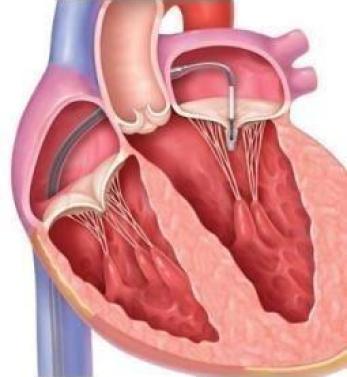

The mitral valve is the valve located between the upper and lower left chambers of the heart. The function of this cover; While allowing oxygenated blood from the lungs to pass into the lower left chamber, it also prevents blood from escaping back into the upper chamber.
What is mitral valve regurgitation?
If the mitral valve does not close properly, blood can escape to the upper chamber, and if it is not closed too severely, it can escape to the pulmonary veins. This condition is called mitral valve regurgitation. Mitral valve insufficiency is the most common heart valve disease in the world.
What are the causes of mitral valve regurgitation? Who gets mitral valve regurgitation?
Mitral valve insufficiency develops in 13-50% of patients who have had a heart attack. Most of these patients are patients who have undergone previous bypass surgery or stent placement. In addition, mitral valve laxity (mitral valve prolapse, MVP) and sometimes tearing of filamentous structures called chordae holding the valve can also cause severe mitral insufficiency. However, congenital diseases and cardiac rheumatism in childhood are also among the triggers of mitral insufficiency. Besides these; Some heart muscle diseases can also cause severe insufficiency of the mitral valve. Severe enlargement of the left ventricle due to heart failure is another important cause of mitral insufficiency.
What are the symptoms of mitral regurgitation?
Common symptoms in patients with mitral regurgitation; shortness of breath, fatigue, rhythm irregularity, edema in the legs. Sometimes, having had a previous stroke can also be a symptom. In patients with severe mitral regurgitation, if the necessary mechanical intervention for the valve is not performed, half of the patients usually die within 5 years.
How is mitral valve insufficiency treated?
Mitral regurgitation is classified as mild, moderate and severe on echocardiography. Mild to moderate mitral regurgitation is treated with drugs. These moderate deficiencies can progress over time and become serious. Treatment of severe mitral valve insufficiency is valve replacement or repair by open heart surgery. However, open heart surgery has a high risk of death or complications in half of patients with mitral regurgitation. These high-risk patients either have other significant co-morbidities or have significant impairment in the contractile function of the heart. Sometimes, advanced age is an obstacle to open surgery in these patients. In these patients who cannot undergo surgery, drug therapy is usually insufficient. In recent years, Mitra Clip therapy has been an important source of hope for these patients.
In which patients can the MitraClip procedure be applied?
MitraClip can be an appropriate treatment modality, especially in patients with additional diseases that may increase the risk of open surgery, patients with significant impairment in heart contraction, and in elderly patients. However, MitraClip cannot be applied to every mitral insufficiency patient (such as mitral valve regurgitation due to rheumatism, valve structure not suitable for MitraClip). The patient diagnosed with severe mitral valve insufficiency is evaluated together with cardiology and cardiovascular surgery specialists before deciding on the treatment method. Whether the structure of the valve is suitable for the procedure is determined by echocardiography performed by entering the esophagus. If the valve structure is suitable for the MitraClip procedure and the patient is at high risk for open heart surgery, the procedure is performed.
How is the MitraClip process applied?
The patient, whose valve structure is evaluated as suitable for Mitraclip, that is, latching, is taken to the angiography laboratory together with the anesthesia department. After the patients are anesthetized and put to sleep, the procedure is started with TOE, that is, endoscopic echocardiography. The right atrium of the heart is reached by entering the inguinal vein without opening the patient's chest. A small hole is opened through the partition separating the right atrium and left atrium, and the left atrium is passed. Then the MitraClip device is passed from the right atrium to the left ventricle, and the mitral valve leaflets are caught in the area where the blood leakage occurs, and latched end-to-end. This method is the same as the suturing performed in open heart surgery. Mitral regurgitation is re-evaluated by performing controls in the follow-up. If the desired level of reduction cannot be achieved, the insufficiency is tried to be reduced by holding the valves with the second, third or even fourth latch. When the insufficiency decreases at the desired level in the controls, the MitraClip system is taken out of the vein and the bleeding is stopped with a few stitches. If it is determined that there is no mishap in the patient's controls after the procedure, the patient is discharged after 1-2 days of observational hospitalization.
What changes in the patient's life after MitraClip procedure?
After mitral valve regurgitation is reduced with this method, it is expected that the patient will have a decrease in shortness of breath and be able to perform daily tasks more comfortably. After this procedure, the need for re-hospitalization is greatly reduced in patients who had to be hospitalized frequently before. It is also known that this procedure has a life-prolonging effect in some patients.